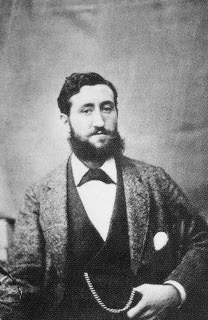Serafino De Tivoli

Serafino De Tivoli (March 1826 – 1892) was an Italian painter of the Macchiaioli group, often referred to as "the father of the macchia" in recognition of his crucial influence on the group's innovative technique.
Biography

Serafino De Tivoli was born in Livorno, Grand Duchy of Tuscany in 1826. He was the first son of Abramo Samuel and Fortunata Moro. In 1836 he moved with his family to Florence. After initial study of literature at a religious private school he attended with his younger brother Felice, he began his artistic training under Carlo Markò the Elder.
In 1848, he fought as a Tuscan volunteer for
In 1855 he exhibited at the Florentine Promotrice exhibition, and in that same year he traveled to Paris for the
In the following years, he made additional visits to Paris, and in 1863 he exhibited in the
He returned to Florence in 1890, where he lived in relative isolation until his death in 1892.
Selected paintings

- Paesaggio con bovi (1855), oil on canvas, Museo civico Giovanni Fattori di Livorno;
- La pesca sul fiume (1855-1856), oil on wood, Pinacoteca Corrado Giaquinto di Bari;
- Paesaggio (1856), oil on canvas, Galleria nazionale d'arte moderna di Roma;
- Paesaggio con cascata (1856), oil on canvas, private collection;
- La questua (1856), oil on canvas, private collection;
- Riposo nel bosco (1857), oil on canvas, private collection;
- Paesaggio sull’Arno (1857), oil on canvas, Galleria d'arte moderna, Palazzo Pitti, Firenze;
- Il ponte di legno, (1857-1859), oil on canvas, private collection;
- Marina con pescatori (1858), oil on canvas, unknown;
- Paese con animali (1858), oil on canvas, private collection;
- Una pastura (1859), oil on canvas, Galleria d'arte moderna, Palazzo Pitti, Firenze;
- Paesaggio con vacche al pascolo (1859), oil on canvas, Galleria d'arte moderna, Palazzo Pitti, Firenze;
- Portico di villa toscana (1859), oil on canvas, unknown;
- Veduta di Villa Salviati (1859), oil on canvas, unknown;
- Veduta del Val d'Arno (Pascolo) (1860), oil on canvas, Galleria d'arte moderna di Torino;
- L’Arno a San Rossore (1860-1864), oil on wood, Pinacoteca Corrado Giaquinto di Bari;
- Ritratto della signora Giovannini (1860-1865), oil on canvas, Galleria d'arte moderna, Palazzo Pitti, Firenze;
- Ritratto del bimbo Giovannini (1860-1865), oil on canvas, Galleria d'arte moderna, Palazzo Pitti, Firenze;
- Grano maturo (1860-1870), oil on canvas, Galleria d'arte moderna, Palazzo Pitti, Firenze;
- Al guado (1862), oil on canvas, Galleria d'arte moderna, Palazzo Pitti, Firenze;
- L’Arno alle Cascine (1863), oil on wood, private collection;
- La lettera alla mamma (1864), oil on canvas, Galleria d'arte moderna, Palazzo Pitti, Firenze;
- Campagna francese (1875), oil on wood, private collection;
- Natura morta con frutta (1875-1879), oil on canvas, Galleria d'arte moderna, Palazzo Pitti, Firenze;
- La Senna a Bougival (1880), oil on canvas, private collection;
Notes
- ^ Steingräber, E., & Matteucci, G. 1984, p. 112.
References
- ISBN 0-300-03547-0
- Steingräber, E., & Matteucci, G. (1984). The Macchiaioli: Tuscan Painters of the Sunlight : March 14-April 20, 1984. New York: Stair Sainty Matthiesen in association with Matthiesen, London. OCLC 70337478
